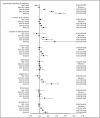The association between body mass index and live birth and maternal and perinatal outcomes after in-vitro fertilization: a national cohort study
- PMID: 37766680
- PMCID: PMC10520462
- DOI: 10.3389/fendo.2023.1239702
The association between body mass index and live birth and maternal and perinatal outcomes after in-vitro fertilization: a national cohort study
Abstract
Objective: To investigate the association between female body mass index (BMI) and live birth rates and maternal and perinatal outcomes after in-vitro fertilization (IVF).
Methods: We performed a national, population-based cohort study including women undergoing IVF between 2002 and 2020. The cohort included 126,620 fresh cycles and subsequent frozen embryo transfers between 2007 and 2019 (subpopulation 1) and 58,187 singleton deliveries between 2002 and 2020 (subpopulation 2). Exposure was female BMI (kg/m2) categorized according to the World Health Organization as underweight (<18.5), normal weight (18.5-24.9, reference), overweight (25.0-29.9), class I obesity (30.0-34.9), class II obesity (35.0-39.9), and class III obesity (≥40.0). The primary outcome in subpopulation 1 was cumulative live birth per started fresh IVF cycle, including fresh and subsequent frozen embryo transfers. Primary outcomes in subpopulation 2 were hypertensive disorders of pregnancy and preterm birth at less than 37 weeks. Risk ratios (RRs) with 95% confidence intervals (CIs) for the association between BMI class and outcomes were calculated using generalized linear models after adjustment for relevant confounders.
Results: The cumulative live birth rate decreased significantly with increasing BMI from 32.6% in normal-weight women to 29.4% in overweight women, 27.0% in women in obesity class I, 21.8% in women in obesity class II, and 7.6% in women in obesity class III. The risk of hypertensive disorders of pregnancy increased significantly and progressively with increasing BMI, from 4.6% in normal-weight women to 7.8% in overweight women and 12.5%, 17.9%, and 20.3% in women in obesity classes I, II, and III. The risk of preterm birth followed a similar pattern, from 6.3% in normal-weight women to 7.5% in overweight women and 8.9%, 9.9%, and 15.3% in women in obesity classes I, II, and III. The risks of other perinatal complications, such as perinatal death, showed an even more pronounced increase.
Conclusion: Using a large and complete national cohort of women undergoing IVF, we demonstrate a dose-dependent decrease in live birth rate and a substantial increase in maternal and perinatal complications with increasing BMI. Strategies to improve this situation are warranted.
Keywords: in vitro fertilization; live birth; maternal and perinatal outcomes; obesity; population registers.
Copyright © 2023 Kluge, Källén, Thurin-Kjellberg, Wennerholm and Bergh.
Conflict of interest statement
LK has received a scholarship from Ferring Pharmaceuticals and completed the ICMJE disclosure form. The remaining authors declare that the research was conducted in the absence of any commercial or financial relationships that could be construed as a potential conflict of interest.
Figures


Similar articles
-
Mild obesity does not affect perinatal outcome in gestational carrier cycles.Hum Reprod. 2024 Jun 3;39(6):1316-1322. doi: 10.1093/humrep/deae079. Hum Reprod. 2024. PMID: 38636947
-
Increased body mass index associated with increased preterm delivery in frozen embryo transfers.J Obstet Gynaecol. 2019 Apr;39(3):377-383. doi: 10.1080/01443615.2018.1523883. Epub 2019 Feb 11. J Obstet Gynaecol. 2019. PMID: 30744438
-
Pre-pregnancy obesity is not associated with poor outcomes in fresh transfer in vitro fertilization cycles: a retrospective study.BMC Pregnancy Childbirth. 2023 Sep 2;23(1):633. doi: 10.1186/s12884-023-05917-7. BMC Pregnancy Childbirth. 2023. PMID: 37660016 Free PMC article.
-
Female obesity is negatively associated with live birth rate following IVF: a systematic review and meta-analysis.Hum Reprod Update. 2019 Jul 1;25(4):439-451. doi: 10.1093/humupd/dmz011. Hum Reprod Update. 2019. PMID: 30941397
-
Guidelines for the number of embryos to transfer following in vitro fertilization No. 182, September 2006.Int J Gynaecol Obstet. 2008 Aug;102(2):203-16. doi: 10.1016/j.ijgo.2008.01.007. Int J Gynaecol Obstet. 2008. PMID: 18773532 Review.
Cited by
-
Obesity: pathophysiology and therapeutic interventions.Mol Biomed. 2025 Apr 25;6(1):25. doi: 10.1186/s43556-025-00264-9. Mol Biomed. 2025. PMID: 40278960 Free PMC article. Review.
-
Endocrine Characteristics and Obstetric Outcomes of PCOS Patients with Successful IVF and Non-IVF Pregnancies.J Clin Med. 2024 Sep 21;13(18):5602. doi: 10.3390/jcm13185602. J Clin Med. 2024. PMID: 39337089 Free PMC article.
-
Effect of body mass index on ovarian reserve and ART outcomes in infertile women: a large retrospective study.J Ovarian Res. 2024 Oct 2;17(1):195. doi: 10.1186/s13048-024-01521-1. J Ovarian Res. 2024. PMID: 39358769 Free PMC article.
-
The impact of obesity on reproductive health and metabolism in reproductive-age females.Fertil Steril. 2024 Aug;122(2):194-203. doi: 10.1016/j.fertnstert.2024.04.036. Epub 2024 May 3. Fertil Steril. 2024. PMID: 38704081 Free PMC article. Review.
-
Impact of blastocyst biopsy for preimplantation genetic testing on maternal and neonatal outcomes following single frozen embryo transfer cycles.BMC Pregnancy Childbirth. 2025 Jan 27;25(1):74. doi: 10.1186/s12884-024-07107-5. BMC Pregnancy Childbirth. 2025. PMID: 39871174 Free PMC article.
References
-
- World Health Organization . Obesity and owerweight (2021). Available at: https://www.who.int/news-room/fact-sheets/detail/obesity-and-overweight.
-
- Petersson K, Skogsdal Y, Conner P, Sengpiel V, Storck Lindholm E, Kloow M. på uppdrag av Graviditetsregistret, Sweden. Graviditetsregistrets Årsrapport 2021. (2022). Available at: https://www.medscinet.com/gr/arsrapporter.aspx
-
- Driscoll AK, Gregory ECW. National Vital Statistics Reports 2020. Prepregnancy Body Mass Index and Infant Outcomes by Race and Hispanic Origin. United States: Centers for Disease Control and Prevention; (2020). Available at: https://www.cdc.gov/nchs/data/nvsr/nvsr70/nvsr70-16.pdf. - PubMed
Publication types
MeSH terms
LinkOut - more resources
Full Text Sources
Medical

